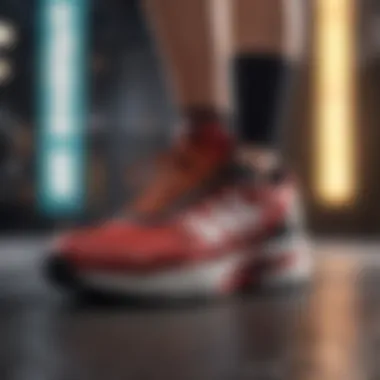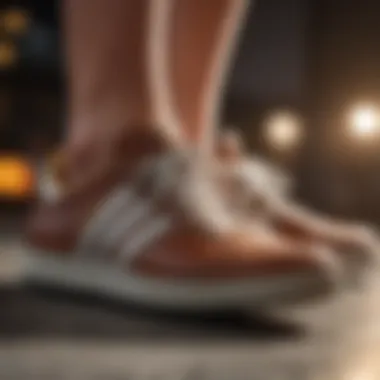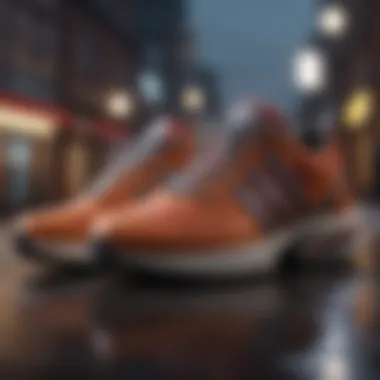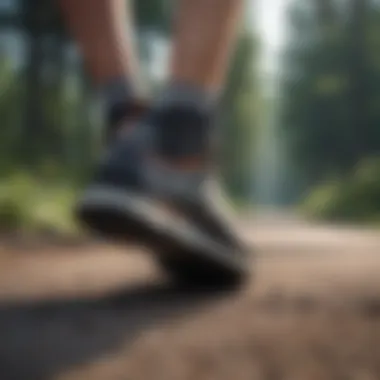Choosing the Best Cushioned Shoes for Walking


Intro
Walking is a fundamental human activity, transcending mere movement. It serves as a gateway to various health benefits, including weight management and cardiovascular improvement. But what often goes unnoticed is the critical role that footwear plays in this activity. Choosing the right cushioned shoes can be the difference between a pleasant stroll and an agonizing trek. The challenge lies not just in aesthetics, but in understanding the different types of cushioning, which can profoundly affect comfort and performance.
In this guide, we will not only dissect the various features of cushioned shoes tailored for walking but will also explore how different foot types and walking styles intersect with these features. Are you flat-footed, or do you possess a high arch? Do you walk briskly or leisurely? Each of these factors becomes pivotal in selecting the ideal pair of shoes.
Before we dive into the specifics, let’s ponder an enlightening point:
"Investing in quality footwear is akin to laying a solid foundation for a house; it supports everything that follows."
With this in mind, it's time to arming yourself with the right knowledge to make an astute decision in your footwear selection.
The Importance of Cushioned Shoes in Walking
When it comes to walking, the shoes on your feet can make a world of difference. Cushioned shoes are not just about comfort; they’re a vital component of walking efficiency, injury prevention, and overall foot health. Both casual walkers and those who take it seriously can benefit from understanding what effective cushioning can do.
Understanding Foot Mechanics
The human foot isn’t just a body part; it’s a complex structure that includes 26 bones, numerous muscles, tendons, and ligaments, working together to absorb shock and maintain balance. Each step we take sends impact forces reverberating through the foot and up the leg. These forces can run anywhere from 1.5 to 3 times your body weight, depending on the intensity of your walk.
Cushioning comes into play here. It acts as a buffer, absorbing much of this shock and reducing the workload on the rest of your body, particularly the knees and joints. Think of it like having a built-in suspension system that automatically adjusts to different terrains. Quality cushioned shoes accommodate the natural movements of the foot, which helps in maintaining proper alignment and reduces fatigue during long walks. When the mechanics are honored, walking becomes more of a leisurely stroll rather than a strenuous task.
Impact of Footwear on Walking Efficiency
Footwear choices have a profound impact on how efficiently you walk. The wrong shoes can lead to poor posture, decreased energy output, and even chronic discomfort. Cushioned shoes are designed specifically to enhance your stride by providing the necessary support and flexibility.
Good cushioning means your feet will exert less energy while walking, making it easier to cover longer distances. Here are some points to consider regarding footwear impacts:
- Energy Return: Well-designed cushioned shoes incorporate materials that not only absorb impact but also return energy to the foot. This means you’re expending less energy and can walk further without tiring as quickly.
- Stability and Balance: A cushioned shoe may offer stability by allowing for a better fit. Shoes that cradle your foot securely help maintain balance, which is crucial, particularly on uneven or unstable surfaces.
- Injury Prevention: By reducing the shock load on joints, these shoes play a crucial role in minimizing risks of injuries such as plantar fasciitis or shin splints. This is especially important for individuals who might be more prone to injury due to age, weight, or pre-existing conditions.
The right pair of cushioned shoes can feel like walking on a cloud, but it’s not just fluff – it’s science working to keep you moving smoothly.
Key Features of Cushioned Walking Shoes
When choosing cushioned walking shoes, understanding the key features is paramount to ensuring both comfort and performance in your stride. Cushioned shoes not just enhance your walking experience but also protect your feet from potential injuries. Factors such as cushioning type, arch support, and material composition are fundamental in determining how well a shoe caters to your unique needs.
Cushioning Technologies Explained
Cushioned shoes come equipped with a variety of cushioning technologies, aimed at absorbing impact and maximizing comfort. Popular components include EVA foam and gel inserts, which not only soften the blow of each step but also add energy return, propelling you forward with ease.
- EVA Foam: Ethylene vinyl acetate, known for its lightweight properties, provides good cushioning but varies by firmness for support.
- Gel Cushioning: Often placed in high-impact areas, gel reduces stress on the bones and joints, essentially acting like a shock absorber.
Understanding these technologies is vital as it not only enhances comfort but also improves efficiency during longer walking sessions. For instance, a well-cushioned shoe minimizes fatigue, enabling you to walk longer distances without discomfort.
Arch Support and Its Significance
One cannot overstate the importance of arch support in cushioned walking shoes. The human foot has three distinct arches, and proper support is critical in maintaining balance and alignment. Lack of adequate arch support can lead to a cascade of issues, ranging from plantar fasciitis to exacerbated knee pain.
- Flat Feet: Shoes with more structured support to help distribute weight evenly can lessen the impact on the lower body.
- High Arches: These may require additional cushioning to alleviate pressure points under the foot.
Finding a pair that addresses your specific arch type ensures you're less likely to develop chronic conditions and more capable of enjoying your walking routine.
Material Composition: Comfort versus Durability


The materials used in cushioned shoes can make or break their performance. It's often a balancing act between softness, comfort, and durability. Some cushion materials may feel plush at first, but they can wear down quickly under pressure, leaving the foot unprotected.
- Mesh Uppers: These allow for breathability while being lightweight, ensuring your feet remain fresh during long walks.
- Rubber Outsoles: Durability is equally important; look for shoes with rubber outsoles that provide traction while lasting over time.
Additionally, pay attention to lining materials. Many offer moisture-wicking properties, which help keep the shoes fresh and the feet dry. It’s this blend of comfort and longevity in material choice that helps make a shoe your reliable companion on the paths you tread.
"The right pair of cushioned shoes can prevent many foot problems and enhance the joy of walking, bridging the gap between health and activity."
Balancing all these features leads to a wise investment in your walking experience, ultimately enhancing not only comfort but also your overall well-being.
Identifying Your Foot Type
Understanding your foot type is a crucial component when selecting cushioned shoes for walking. Each foot comes with its unique mechanics, and knowing these details can significantly impact your walking comfort and overall health. By identifying whether you have flat feet, high arches, or neutral feet, you can make an informed choice about which shoe features will serve you best.
An ideal cushioned shoe provides the right amount of support and cushioning according to your specific needs. Not all shoes fit all foot types, and wearing the wrong shoe can lead to discomfort, pain, and even injuries over time. Therefore, this section's insight on foot types will guide you to find shoes that complement your natural foot structure, ensuring optimal walking efficiency.
Flat Feet versus High Arches
Flat feet, or fallen arches, are a condition where the arch of the foot is either very low or non-existent. This can lead to an imbalance during walking, as the foot tends to roll inwards. Individuals with flat feet may benefit from shoes that offer ample arch support and stability. Look for cushioned shoes that feature well-padded insoles, which help to distribute body weight evenly and absorb impact effectively.
"Support is key when it comes to cushioning for those with flat feet. Stability features in shoes can make a world of difference in avoiding discomfort over long periods of walking."
On the other hand, high arches present a different set of challenges. Those with high arches often experience insufficient contact with the ground, leading to increased pressure on the balls and heels of the feet. Ideally, individuals with high arches should seek shoes with extra cushioning, especially under the heel and forefoot, to alleviate impact and promote alignment. Shoes designed with responsive foam can provide the necessary softness and bounce.
Neutral Feet: Finding the Right Fit
Neutral feet lie somewhere between flat and high arches, exhibiting an optimal balance. Those with a neutral foot type often have a slight arch that supports efficient walking mechanics. For these individuals, cushioning is essential yet should not be overly excessive.
When selecting shoes for neutral feet, the goal is to find a balance of cushioning that provides comfort without sacrificing support. Look for walking shoes that offer moderate cushioning and a flexible construction. This helps in maintaining the natural motion of the foot while ensuring that the foot remains well-supported throughout the activity.
Additionally, make sure to assess the fit of the shoe thoroughly. Sizing can vary from different brands, so it’s worthwhile to try on several pairs to see which one hugs your foot without pinching or cramping. Since each foot is unique, remember to pay attention to how the shoes feel on your feet during different activities. This personalized approach will guide you toward finding shoes that feel like a second skin.
Top Recommended Cushioned Shoes for Walking
Walking shoes are not just about aesthetics or general comfort; they play a pivotal role in your physical well-being. The right cushioned shoes can make a significant difference in your overall walking experience, leading to improved efficiency and reduced risk of injuries. When choosing the best cushioned shoes for walking, it's essential to consider specific elements such as performance, budget, and individual requirements. This section dives into some top recommendations, highlighting various options available in the market.
High-Performance Walking Shoes
For those who take their walking seriously, high-performance shoes are non-negotiable. They're built with a blend of innovative cushioning technology and rigorous engineering designed for support under demanding circumstances. In this category, shoes like the Hoka One One Bondi 8 and the Brooks Ghost 14 stand out.
- Hoka One One Bondi 8: Known for its plush cushioning, it’s like walking on clouds. The ample padding absorbs shock well, making it a favorite among long-distance walkers.
- Brooks Ghost 14: It’s a versatile option that offers a responsive feel. The cushioning balances comfort and support effectively, catering to those who might love to walk and jog interchangeably.
High-performance options usually have longer lifespans, allowing you to enjoy maximum value while guiding your feet along smooth and uneven paths. Opting for shoes designed for active performance can yield benefits like enhanced stability and comfort during extended walking sessions.
Budget-Friendly Options
Not everyone wants to break the bank while looking for quality cushioned shoes. Thankfully, the market also offers some reliable and cost-effective choices. Shoes such as the New Balance Fresh Foam 880v11 and the ASICS Gel-Venture 8 prove that you can find comfort and support without spending a fortune.
- New Balance Fresh Foam 880v11: This model gives you a great balance of cushioning and support, perfect for casual walkers. The material is soft, yet holds up well for everyday wear.
- ASICS Gel-Venture 8: While it’s made for trails, its comfort makes it suitable for everyday walks too. The gel cushioning technology assists in shock absorption, which helps reduce fatigue.
Budget-friendly doesn’t mean sacrificing quality; rather, it means making smart choices. These shoes are crafted thoughtfully, ensuring you get the support you need without an extravagant price tag.
Best Shoes for Specific Conditions
When walking, certain physical conditions can affect your choice of shoes, such as overpronation, plantar fasciitis, or other foot-related issues. Selecting shoes specifically designed to accommodate these conditions is critical.


- Saucony Guide 14: Excellent for those experiencing overpronation, as the shoe provides medial support to guide the foot during strides, preventing excessive rolling inward.
- Adidas Ultraboost 22: This option provides good arch support and is often recommended for those dealing with plantar fasciitis. The boost technology promotes energy return, making every step feel lighter.
Choosing shoes that cater to your specific needs can lead to enhanced comfort and mobility, reducing the chances of making an existing condition worse. It's not just about walking; it's about walking well. So consider your personal needs, and don't hesitate to consult a professional if you're unsure about the best option for you.
"The right footwear not only augments one’s walking experience but also ensures that each step is taken with confidence and support."
Assessing Fit and Comfort
When it comes to footwear, the saying "fit is king" really rings true, especially for cushioned shoes designed for walking. It's not enough just to buy a pair that looks appealing; the comfort and proper fit can significantly affect your overall walking experience. Finding shoes that hug your feet just right can prevent discomfort, blisters, and long-term foot problems, creating a foundation for your overall health while walking.
Several elements play key roles in ensuring that a shoe fits well. These include the shape of the shoe, the tightness across the midfoot, and the accommodation for toe wiggle room. Missing the mark on any of these aspects can lead to foot fatigue or injuries. The benefits of a well-fitting shoe are evident: fewer distractions, better performance, and an increased likelihood to enjoy longer walks.
Sizing: The Key to Comfort
One of the most crucial things to consider when selecting shoes is sizing. Many people stick to the size they think they should wear but fail to account for changes in foot size over time. Factors like age, weight fluctuations, and even pregnancy can alter the size and shape of our feet.
Getting a professional fitting is a smart move, but if that's not possible, be sure to measure your feet regularly. It's simple: stand on a piece of paper, trace around your foot, and measure the length from heel to toe. Choose the shoe size that corresponds to these measurements. Remember, sizes can vary between brands, so it's best not to rely on just one brand's sizing chart.
"Being comfortable in your shoes is like finding the right partner; it should feel natural and supportive."
A snug fit is essential, but you want to avoid shoes that are too tight. Ideally, there should be enough room to fit a thumb's width between your longest toe and the front of the shoe.
Trying Shoes in Different Scenarios
Choosing the right shoes isn’t simply a matter of trying them on and walking a few steps inside the store. It’s essential to put them through several practical tests in environments where you actually walk. This ensures that the shoes not only fit but also perform in real-life situations.
Indoor vs. Outdoor Testing
When considering indoor versus outdoor testing, it’s crucial to recognize how each setting affects your perception of shoe comfort and versatility. Indoor surfaces are generally flat and predictable, while outdoors can have varied terrain, from grass to pavement.
Testing shoes indoors might give you an initial impression of fit, but outdoor conditions reveal how the shoes handle uneven terrain, moisture, and temperature shifts. The key characteristic of outdoor testing is the need for shoes to offer flexibility and stability across numerous surface types, which elevates this choice as a definitive measure for long-term satisfaction.
Walking on Varying Surfaces
Walking on varying surfaces is another important element. From smooth concrete to gravel paths, different surfaces engage the shoes in unique ways. Some cushioning materials excel on soft ground while others provide better traction on harder surfaces. Understanding how shoes feel on surfaces that you commonly walk on will help you identify the best options for your needs.
The unique feature of testing on varied surfaces is that it allows a comprehensive assessment of both comfort and durability. Shoes that perform poorly on certain surfaces might not be worth the investment.
Duration of Wear
The duration of wear during your trials is yet another factor to consider. Long-term wear testing provides insight into how the shoes hold up after multiple hours of being on your feet. You may feel that a shoe fits well at first, but how does it feel after a long walk or several hours?
Often, a shoe that feels great during a quick test may lead to discomfort after extensive use. Therefore, making sure comfort persists over prolonged periods can be a deal-breaker in selection.
Testing shoes under various conditions ensures that you absolutely maximize your walking experience. Sizing, surface testing, and duration of wear all play vital roles in finding the most suitable cushioned shoes for walking, ensuring you get the best of both comfort and performance.
Maintaining Your Cushioned Shoes
Keeping your cushioned shoes in tip-top shape isn’t just about aesthetics; it’s crucial for maintaining their comfort, support, and durability. Shoes, much like any tool, require care to ensure they function as intended. Without proper maintenance, you may find your walking experience suffers—your shoes may lose the cushioning that makes them so essential.
Regular upkeep prolongs the life of your footwear, ultimately saving you money in the long run. Additionally, a well-maintained pair of cushioned shoes reduces the risk of injuries caused by worn-out materials or inadequate support.
Cleaning and Care Instructions


Cleaning your cushioned shoes might seem like a mundane task, but it’s one of the best investments you can make toward prolonging their life. Here are steps to consider:
- Wipe Down: Use a damp cloth to remove dust and dirt from the upper part of the shoe. For stubborn stains, mild soap can be useful. Just be careful; you don’t want to soak them and ruin the cushioning!
- Remove Insoles: If your shoes come with removable insoles, take them out and air them out regularly. This not only prevents stink but also allows any moisture to escape, reducing the chance of mildew.
- Machine Wash: Some shoes can be machine-washed, but make sure to check the label first. If so, it’s best to use a gentle cycle and place them in a laundry bag to avoid damage.
- Dry Naturally: Avoid direct heat sources when drying your shoes. Instead, let them air dry away from sunlight. Using a fan could also help speed up the drying process.
- Regular Inspection: Examine your shoes regularly. Look for signs of wear, check the soles for cracks, and make sure the cushioning is intact.
Proper cleaning not only protects your investment but also enhances your overall walking experience by ensuring that your shoes stay in peak condition.
When to Replace Your Shoes
Recognizing when to replace your cushioned shoes is just as essential as knowing how to maintain them. Shoes can wear down gradually, and it may not be immediately evident that they no longer provide the support you need. Here are a few pointers:
- Mileage Check: If you're walking regularly, a good rule is to consider replacing your shoes after about 300-500 miles of walking. Keeping track of this can help you know when a change is due.
- Change in Fit: If your shoes feel different—too loose or too tight—it might be a sign that the cushioning inside has compressed.
- Visible Wear: Look for signs of wear on the soles and uppers. If you can see the ground or feel a significant difference in the cushioning when you walk, it’s time to consider a new pair.
- Discomfort or Pain: If you find that you are experiencing unusual discomfort or pain while walking, even after ensuring your shoes are clean and fit well, it could indicate they’ve reached the end of their life.
- Odor and Moisture: Persistent odors or moisture retention can also signal that your shoes need to be replaced.
In sum, keeping an eye on the lifespan of your cushioned walking shoes can greatly contribute to your health and comfort. Knowing how to clean and when to replace them ensures your walking experience remains a pleasant and beneficial one.
The Future of Cushioned Walking Shoe Technology
As we step into a new era of walking shoe technology, the evolution of cushioned shoes stands at the forefront. This development is not only about comfort but also focuses on health benefits that ripple through the daily lives of individuals. With more awareness surrounding foot health and its impact on overall wellness, innovations in cushioning technology serve a dual purpose: enhancing walking experiences and preventing injuries associated with improper footwear. The strides made in this area signal a shift toward customized solutions that cater to individual foot dynamics and preferences. Here, we delve deeper into what lies ahead for cushioned walking shoe technology, highlighting specific elements and their advantages.
Innovations in Cushioning Materials
The materials used in cushioned shoes have come a long way from traditional foam. Companies are now experimenting with next-gen materials like
- Gel: These products absorb shock effectively while providing stability. Popular brands have integrated a gel layer in their midsoles to reduce pressure on joints.
- Liquid-filled technology: Some footwear now incorporates liquid layers that adapt to walking patterns and foot strikes. This dynamic cushioning responds uniquely, improving comfort and support in real time.
- Memory foam: It has gained popularity for its ability to contour to the foot's shape. Walking shoes that utilize such materials provide tailored comfort, cradling the foot and ensuring even weight distribution.
Each of these innovations tackles the common pitfalls of conventional shoe cushioning – such as lack of breathability or quick breakdown under pressure – making future models not just a choice of comfort, but also a maintenance of foot health.
Sustainability in Footwear Production
The topic of sustainability is increasingly influential in how walking shoes are produced. With rising environmental concerns, the shoe industry is beginning to blend high performance with eco-friendliness. Manufacturers are looking for ways to make production methods sustainable without sacrificing the quality of their footwear. This focus encompasses several elements:
- Biodegradable materials: New initiatives are aiming to incorporate materials that break down more naturally, reducing landfill contributions once shoes are discarded.
- Recycled components: Utilizing old shoes to create new models is becoming more commonplace. This practice not only conserves resources but also infuses new life into the shoes we discard after use.
- Ethical manufacturing: Being mindful of how, where, and by whom shoes are made is gaining traction. Brands starting to prioritize fair labor practices and minimizing environmental impact reinforce consumer confidence.
Ultimately, consumers are increasingly inclined to purchase products that align with their values about sustainability and environmental responsibility. As walking's popularity continues to scale, expect manufacturers to bolster their offerings with initiatives aimed at reducing ecological footprints, making sustainable choices an appealing option for serious walkers.
Ultimately, the future of cushioned walking shoes lies at the intersection of technology and sustainability. By embracing innovations in cushioning materials along with ethical production practices, consumers will not only enhance their walking experience but also contribute positively to the environment.
Culmination: Making Informed Choices
Choosing the right cushioned shoes for walking is crucial for anyone serious about their health and physical activity. Understanding the right features, knowing your foot type, and being aware of different walking styles are vital factors in this decision-making process. Once you have decoded these elements, you’re not just buying a pair of shoes; you’re investing in your overall well-being. This enables you to walk comfortably, reduce the risk of injuries, and ultimately, enjoy the experience of walking.
This article has outlined the various aspects one should consider. Among them are cushioning technologies, arch support, and the materials used in footwear. Each factor plays a pivotal role in ensuring that your walking experience is not just enjoyable but also sustainable in the long run. Remember, it’s not just about aesthetics—it’s about what is going to support your feet and body effectively.
"Comfort isn’t just a luxury; it's a necessity when it comes to choosing walking shoes."
Being informed means you can discern quality from mere marketing gimmicks. It is essential to prioritize features that align with your specific foot needs, whether they be high arches, flat feet, or neutral posture. This will greatly enhance your comfort levels, especially during long walks.
Finally, considering future technologies in cushioned shoe design can also be beneficial. Keeping an eye out for innovations might lead you to shoes that provide even greater levels of support and comfort. It’s about making sure you’re always one step ahead in your walking journey.
Summarizing Key Takeaways
- Foot Mechanics: Knowing how your foot works is fundamental. Understanding your foot type can help guide you towards the right cushioning technologies.
- Cushioning Technologies: Different types of cushioning serve various purposes—from shock absorption to stability—which influence walking efficiency.
- Arch Support is Key: Proper arch support is a non-negotiable in a quality walking shoe. It’s essential for preventing fatigue and discomfort.
- Fit Matters: Always prioritize fit over fashion. A good fit reduces the risk of blisters and other foot ailments.
- Innovations in Design: Stay updated on new technologies and sustainable practices in footwear. This can improve your overall walking experience while being eco-conscious.
Encouragement for Next Steps in Walking
Once you’ve made your informed choice about cushioned shoes, the next step is to lace them up and hit the pavement. Whether you’re walking for leisure, exercise, or even meditation, allow yourself the space to find your rhythm.
Start with short distances and gradually increase as your feet adjust to your new footwear. It’s crucial to listen to your body; consider your comfort levels and any signs of pain or discomfort. Remember, consistency is key. The more you walk, the more your endurance and strength will build over time.
Engage with community forums and discussions on platforms like Reddit to connect with fellow walkers or fitness enthusiasts. This can provide you with additional insights and motivation as you pursue your walking goals.
Ultimately, making informed choices about your footwear is just the starting line in your walking journey. It sets the pace for a healthier lifestyle. So, invest some thought, make the right decisions, and enjoy the walk ahead.







